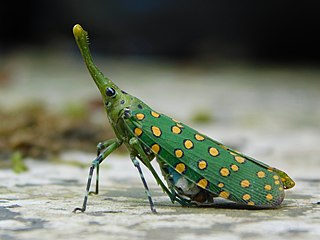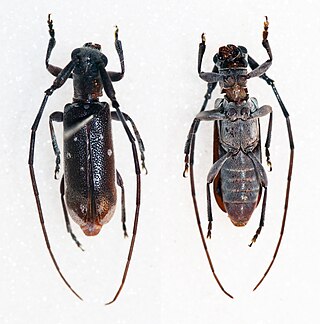
The small-spotted lizard is a species of lizard. It is found in the following countries: Morocco, Algeria, Tunisia, Libya, Egypt, Sinai, Israel, Saudi Arabia, Iran, India, S. Turkmenistan, N. Africa, Afghanistan, Pakistan, Senegal, Niger, Sudan, Syria. Type locality: Egypt.

Saiva is a genus of Asian planthoppers, family Fulgoridae. They are colourful insects, marked boldly in red, blue, white and black, with a prominent slender stalk like structure arising on the head that points upwards or forward. The known distribution is from India, through Indo-China to Borneo.

The guttulate foliage-gleaner is a species of bird in the Furnariinae subfamily of the ovenbird family Furnariidae. It is endemic to Venezuela.
Peperomia guttulata is a species of plant in the family Piperaceae. It is endemic to Ecuador.
Pterocalla guttulata is a species of ulidiid or picture-winged fly in the genus Pterocalla of the family Ulidiidae.

Restrepia guttulata, commonly called the small-spotted restrepia, is a species of orchid occurring from Venezuela to Ecuador.

The diamond turbot is a flatfish of the family Pleuronectidae. It is a demersal fish that lives in subtropical waters on sand or mud bottoms at depths of up to 50 metres (160 ft), though it is most commonly found between 1 and 20 metres. Its native habitat is the coastal areas of the eastern Pacific, from Cape Mendocino, California in the north to Baja California in Mexico in the south. The turbot is dark green with light blue spots. It reaches up to 46 centimetres (18 in) in length, and its maximum reported lifespan is 9 years.

Eunidiini is a tribe of longhorn beetles of the subfamily Lamiinae. It was described by Téocchi et al. in 2010.

Eunidia is a genus of longhorn beetles of the subfamily Lamiinae.

Eunidia tripunctata is a species of beetle in the family Cerambycidae. It was described by Per Olof Christopher Aurivillius in 1911.
Eunidia batesi is a species of beetle in the family Cerambycidae. It was described by Olliff in 1889.

Eunidia thomseni is a species of beetle in the family Cerambycidae. It was described by William Lucas Distant in 1898. It is known from Tanzania, Cameroon, Chad, Niger, Ethiopia, Senegal, Mozambique, Botswana, Namibia, Saudi Arabia, the Central African Republic, Somalia, Uganda, South Africa, Yemen, Kenya, and Zimbabwe.
Corrhenes guttulata is a species of beetle in the family Cerambycidae. It was described by Francis Polkinghorne Pascoe in 1865. It is known from Australia.
Eczemotes guttulata is a species of beetle in the family Cerambycidae. It was described by Henry Walter Bates in 1877.
Trigonoptera guttulata is a species of beetle in the family Cerambycidae. It was described by Gestro in 1876, originally under the genus Arsysia.

Ephemera guttulata, commonly known as the eastern green drake, shad fly and coffinfly, is a species of mayfly in the genus Ephemera. The eastern green drake is native to the continental United States and Canada. Its conservation status per the NatureServe conservation status ranking system is G5, meaning it is secure.

Ephemera simulans is a species of mayfly. It is commonly found throughout the United States. The species is used for fly fishing.
Namunaria guttulata is a species of cylindrical bark beetle in the family Zopheridae. It is found in North America.

Naxa is a genus of moths in the family Geometridae described by Francis Walker in 1856.
Calcipostia is a monotypic genus of fungi belonging to the family Fomitopsidaceae. The only species is Calcipostia guttulata.











